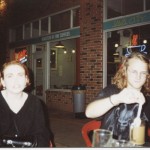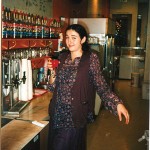Living in Java City
Posted on June 3, 2011 – 5:34 AM | by AdminBy William Burg
In the 1960s, when “Starbuck” was still just a character in Moby Dick, Sacramento’s first coffeehouses jangled the nerves of the Beat Generation. In Oak Park, artist Sal Yniguez opened the Belmonte Coffee Shop at 2975 35th Street in 1962, a beatnik café inhabited by artists like Wayne Thiebaud, Gregory Kondos and Russ Solomon (profiled in Midtown Monthly, February 2010). At about the same time, the Iron Sandal, a coffeehouse at 23rd and Broadway, featured live jazz, and nurtured local musicians like saxophonist Mel Martin. Hipsters and beatniks from CSUS and Sacramento State, local artists and musicians, and the first stirrings of Sacramento’s gay community found refuge at these cafes in the Sixties.
Midtown’s first coffee shop of note was the Weatherstone, opened in 1974. According to Michelle Fong, a Midtown resident in the 1980s, Weatherstone featured big couches, a piano, and an enormous unabridged dictionary on a stand. Proximity to a laundromat and the nearby Oasis Ballroom drew a mixed crowd of nearby residents and music fans. “Weatherstone encouraged you to kick back,” said Fong. “You could spend half a day there.” Pastries and coffee were delivered regularly from San Francisco.
Other central city cafes of the 1970s and 80s included Tara’s Place, Juliana’s Kitchen, Espresso Metro, Terra Roxa and Gelato Robi, but the first local coffeehouse to roast their own beans was Java City. Founded by former state employee Tom Weborg at 18th and Capitol in 1985, Java City’s roasting operation filled the neighborhood with a distinct aroma that drew residents from Midtown and workers from Downtown office buildings.
 In 1986, Java City hosted its first poetry marathon, the brainchild of local poet B.L. Kennedy. Poetry marathons and high-quality coffee cemented Java City as Midtown’s cultural epicenter. At night, Java City was the only business for blocks, an oasis of light at 18th and Capitol. The neighborhood was far less safe than it is today; young women on their way to Java City were sometimes propositioned by passing cars, mistaken for the streetwalkers who worked near Georgian’s Casino on J Street. Java City became a cross-section of the city: new wave shop girls in leopard print coats and cat-eye glasses, poets, musicians and artists trading work and opinions, punks and skinheads in flight jackets and Doc Martens, recovering alcoholics and addicts taking a break from AA meetings at nearby Group One, bikers, retirees, office workers, urban professionals, and disabled residents of nearby board and care homes.
In 1986, Java City hosted its first poetry marathon, the brainchild of local poet B.L. Kennedy. Poetry marathons and high-quality coffee cemented Java City as Midtown’s cultural epicenter. At night, Java City was the only business for blocks, an oasis of light at 18th and Capitol. The neighborhood was far less safe than it is today; young women on their way to Java City were sometimes propositioned by passing cars, mistaken for the streetwalkers who worked near Georgian’s Casino on J Street. Java City became a cross-section of the city: new wave shop girls in leopard print coats and cat-eye glasses, poets, musicians and artists trading work and opinions, punks and skinheads in flight jackets and Doc Martens, recovering alcoholics and addicts taking a break from AA meetings at nearby Group One, bikers, retirees, office workers, urban professionals, and disabled residents of nearby board and care homes.
Former employee Nick Roberts, who worked at Java City in 1991-1992, said that the job could be frustrating, due to the sometimes too-close eye of supervisors, but he, like many employees, spent almost as much time hanging out at Java City as he did working. “Even after I got off work, I’d still find myself there—virtually everyone I knew would be there.” In addition to the social scene, the drinks themselves were excellent—Roberts waxed poetic about the “Fro-Mo,” a chocolatey mixture of gelato and espresso. “Whenever anyone ordered it, I deliberately made too much, and saved the extra for myself!”
 By the 1990s, coffee became a big business, and Java City expanded into a regional chain, opening shops throughout northern California. Other cafes opened nearby, such as New Helvetia, which turned an old 1893 firehouse from a heroin shooting gallery into a coffeehouse. No Jive Java, an upstart operation run by former Java City employees, opened up right next door to Java City, offering lower prices and later hours, but only lasted a few years. Capitol Garage at 15th and L Street added live music to the mix, becoming a prominent music venue before relocating to its current digs at 16th and K. Java City’s expansion was followed by contraction, as competing national chains opened franchises on every block, but the flagship location remains at 18th and Capitol.
By the 1990s, coffee became a big business, and Java City expanded into a regional chain, opening shops throughout northern California. Other cafes opened nearby, such as New Helvetia, which turned an old 1893 firehouse from a heroin shooting gallery into a coffeehouse. No Jive Java, an upstart operation run by former Java City employees, opened up right next door to Java City, offering lower prices and later hours, but only lasted a few years. Capitol Garage at 15th and L Street added live music to the mix, becoming a prominent music venue before relocating to its current digs at 16th and K. Java City’s expansion was followed by contraction, as competing national chains opened franchises on every block, but the flagship location remains at 18th and Capitol.
Pickles T. Catt, a regular of many Midtown coffeehouses, reflected on them fondly. “I thank God for those places. I had the best times of my life hanging out at those spots. I don’t know if it’s the age I was or just being old and jaded now, but when I was hanging at those spots it was such a great mix of people and, as weird as it sounds, its own community. Nowadays, most coffee shops seem soulless.”
Today, you can’t swing a dead cat in Midtown without knocking over someone’s double latte, even if it’s more likely to spill on their laptop or smartphone than a copy of Camus’ No Exit or a notebook of poetry and sketches. Midtown café regulars include plenty who first sat at Java City, Weatherstone or other long gone café decades ago, joined by a new generation seeking high-quality beans and free Wi-Fi. All seek inspiration and energy, both from the stimulant effects of caffeine and the atmosphere of a Midtown café.



6 Responses to “Living in Java City”
By Penny Tafoya on Jun 4, 2011 | Reply
My friend of 26 years, Kathy Smith, didn’t open in Midtown or downtown, but in 1984 she opened Coffee, Tea, and Co, in Lakecrest Village at Florin Road and I-5 in Greenhaven. She was a coffee shop pioneer in the ‘burbs. I’ve been a coffee snob, ever since she taught me the ins and outs of coffee.
Since she closed, my favorite place for coffee is Coffee Works on Folsom on the west end of East Sac. Dark Star and American roast Sumatra, mixed 1/2 and 1/2-da bomb!
By William Burg on Jun 4, 2011 | Reply
I have already been chided for not mentioning Coffee Works, which apparently started roasting in-house three years before Java City–Dark Star is hands down my favorite coffee. I could have gone much farther with this article, in terms of locations and geography (I didn’t mention my old Citrus Heights haunt Star Cafe, for instance) but Old Man Foster spends enough time hassling me about deadlines and word count as it is. Count on a follow-up article someday.
By ya boy on Jun 12, 2011 | Reply
java city on 18th was the place where the punks and skins and other troublemakers would meet up BEFORE the party. This was pre cell phone, pre internet, pre pager even lol. You had to show up here first to find out what was going on later that night – where the shows were, where the houseparties were… WB hit it pretty square on the head – such a wild mix of people. Bikers, AAs, skins, punks, mods, visigoths (lots of these back in the day. someone needs to bring that whole thing BACK!) haha.
By ed on Jun 21, 2011 | Reply
Totally, you nailed the description of JC’s old character-I remember it quite fondly
By Joyce Cristoni on Nov 25, 2015 | Reply
I was amazed when I heard there was something about the Iron Sandal in this blog. I am 80 years old and was a silent partner in the Sandal with Seeley Burette Inch (Bob passed away in Hawaii a few years ago and Chris Williams.
A Deputy DA by the name of Hugh Evans told me about his son that was a lawyer and he Hugh set us up with the man that owned the property on Broadway. That man was a friend of one of my aunts and loaned me the money to go into business with him as a silent partner. I went from a beatnik to a nurse and retired years ago. I spent years in Canada and lived at the Royal Victoria Yacht Club on the Island. I called Hugh as soon as I moved back to Sacramento. I now live in the foothills after selling my property a few months ago.
Mr. Evens turned my life around from a hippy teen ager to a part of society that I was proud of and I edited the news letter for the Sacramento Ostomy assn. until a few years ago when my second husband passed away after retiring from Law Enforcement had also edited a newsletter for Freed in Grass Valley after my husband came back from Viet Nam as an Agent Orange Victim I also worked pro bono for the Cancer Society of Northern California to hook up people with a place to order their Pharmaceuticals that had lost internal body parts due to cancer. Glad to see someone remembers the good old Iron Sandal. I took my website down last year as I am not well enough to do the work it required to keep it up. Joy